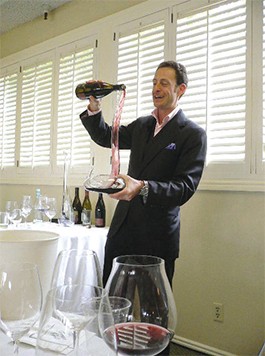Wine potentate Robert Parker Jr. once said of Riedel stemware: “The effect of these glasses on fine wine is profound.” For 11 generations, the Riedel family has dealt in glass, and in the 20th century, that expertise translated into goblets so deftly designed that the prototype ended up in the Museum of Modern Art. Last month Maximilian Riedel, who heads up the family’s New York office, explained to a crowd of California restaurateurs and winemakers how his glassware enhances the expression of fine wines. He was convincing.
First off, let’s clarify. Riedel makes over 300 different kinds of stemware–glasses to suit specific beverages and wine varietals, hand-blown lead crystal glasses and lead-free, machine-crafted glassware for tasting rooms and restaurants. Glasses, as the whippet-thin Herr Riedel explains, “translate the message of the wine.”
We began with a sharply tapered beauty “designed in response to more dense and concentrated wines.”In this case, a Sauvignon Blanc. Next to it, a lavish goblet with the Burgundian inward pinch about one-half inch from the top was designed specifically for Pinots, and another, with a short stem and tall flowing balloon, was “developed between 1993 and 1995,”Riedel explained, “after tastings in every major Syrah growing region. The winemakers contributed their views, and we came up with this.”He brandished the delicate glass filled with a 2004 Michaud Syrah from Chalone, exuding roses and black pepper.
“Glass has a great impact on the wine,”he intoned, spitting expertly into a nearby bucket. “If we taste wine in different glasses, the perception is going to be different.”And it was. Swirl, look, sniff. We learned about the four taste zones on the palate: sweet, sour, salty, bitter. We were urged to note mouth feel and umami as the angular Sauvignon Blanc glass channeled the wine straight to the tip of our tongue. That way, we first taste the herbal notes, not the wine’s high acidity. Noting the silkiness and aromatic nuance, I swallowed. Sure enough, there was a Granny Smith apple finish. “This is a very good food wine,”he beamed.
The ample curves of the Syrah glass, on the other hand, coaxed the flow of wine to the mid-palate, where the silky mouth feel and sensuous fruit was foregrounded, with tannins following. To make his point–and this was done with each of four different wines–Riedel had us pour wine from his glassware into a thick-rimmed, generic restaurant goblet. The results? “No aroma, very acidic and short aftertaste,”he said, reading our minds. We poured the wine back into the Riedel glass and–voilà! –the complexity returned.
Riedel glassware in each case enhanced the wines–an added value for tasting rooms and restaurants–and for consumers willing to pay from $10 to $50 for something that can always be broken.
Quick dining snapshots by Bohemian staffers.
Winery news and reviews.
Food-related comings and goings, openings and closings, and other essays for those who love the kitchen and what it produces.
Recipes for food that you can actually make.











